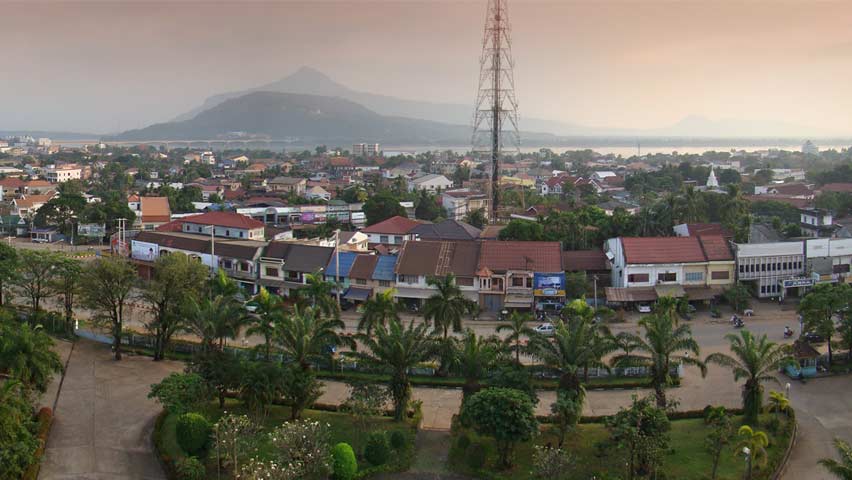experience southern laos
Visit Pakse

Pakse is a city with a charm all its own and surprising landscapes that contrast with this effusive city, that has developed more slowly compared to its cousins in the north, such as Luang Prabang or Vientiane. The name of the 2nd city of Laos comes from the contraction between “Pâk” (mouth) and “Se”, the diminutive name of the Sedone River, a major tributary of the Mekong. The city, bordered by these two major bodies of water, is the place where they meet nicknamed “Sopse” (lips of se).
Your day starts by car from Champasak and you can enjoy the wonderful views of the splendid mountainous landscapes, littered with green rice fields and traditional villages of the South. Your first stop is at the impressive Golden Buddha Wat Phou Salao, overlooking the city of Pakse which offers a superb panorama of the province of Champasak. The more energetic will want to climb the 200 steps to reach the temple, or you can stay in the vehicle to reach the summit.
Buddhist temples are very hospitable, and you can go take a look inside, where the monk will probably come to you to bless you with a string of baci (or phouk khene). Phou Salao is far from being the most beautiful temple of the city but it is very pleasant and you can find a very realistic wax monk who hangs in a room alongside many Buddhist figurines. Do not forget to leave a small kip note in the jar at the feet of the monk after the blessing before retiring with your head and back bowed to show your respect.
After descending the Phou Salao mountain, you cross the “Japanese Bridge” over the Mekong. The river is particularly imposing and offers a beautiful view. Your guide will take you to the unmissable and sultry Dao Hueang Market, one of the largest in South East Asia. All your senses will be impacted during this discovery of the out of the ordinary, with rich colours and powerful aromas.
It takes time to explore the market as you meander between the stalls because Dao Hueang is a modern-day labyrinth. Here you can find everything and ask for help from your guide to find the best stalls and negotiate prices, a sport whose etiquette must be measured with patience and smiles: beautiful jewels hidden between extremely kitsch jewels in gold and quality silver, exotic fruits with a thousand colors and flavours to be absolutely enjoyed, fresh tobacco grown in the Lao countryside and sold in large rice bags, desserts such as caramelized sugar cane sold packaged in bamboo leaves, fragrant padaek jars, Laos’ fermented fish sauce, an impressive array of fabrics, neglected counterfeits, finger-sized and oddly functional cell phones, hilarious t-shirts to nearly translated into English … are some surprises among others to find at the Dao Hueang Market.
After this urban adventure, we will rest in a small inn on the banks of the Sedone where you can enjoy a traditional Lao “nem khao” for lunch. The chef prepares delicious dishes at reasonable prices and you will find many local specialties such as papaya salad or Mekong fish in salt. Enjoy this soothing place at the water’s edge, popular with local gourmets and relatively unknown to tourists.
You continue your exploration of Pakse on the other side of the Sedone River where find a Chinese temple located at the branch of Sopse. The view here is wonderful and popular with young local people at the end of the day.
You head towards the north of the city and Wat Chomphet and its huge Buddha statue under which nestles a temple where female monks will bless you with a baci bracelet. The monks are always happy to receive foreign visitors and, if you feel like it, take a few minutes to chat with them. Asking many questions in Laos is not considered harsh, quite the contrary: it is a sign of interest and sympathy that will be greatly appreciated. Here you can try some of the activities that Lao do at the temple: make a wish and try to haul a small, heavy Buddha statuette over your head three times, if you can. The temple of Wat Chomphet is very popular with locals because its monks have the reputation of having some mystical powers. It is also on the dirt road that leads to it that are manufactured many statues of Buddha carved in stone and sold to the temples of the region. You stop to meet these local stone cutters and observe their unique skills.
We will end the day with a refreshing cocktail and amuses-bouches at Panorama, the rooftop restaurant of the Pakse Hotel, which offers a splendid view of the city. Cradled in the dazzling colors of the end of the day on the rivers and mountains that surround Pakse, you can enjoy the sunset and you will be able to spot the Golden Buddha at Wat Phou Salao in the distance.
Estimated time: 6-9 hours
Note: When visiting temples, consider wearing clothes covering knees, shoulders and cleavage. The discovery of Pakse is a flexible day and we can add or take out different parts of the day, as you wish. Talk to the team at our travel desk to find out about the different options.
